Understanding energy systems is important for personal trainers as this knowledge underpins our knowledge of how the human body works and relates to exercise principles.
Energy systems directly relate to programme design. Understanding the mode and utilisation of "energy in" can help you best review and observe the chronic and acute responses to training stimuli. Energy systems dictate the reasoning behind rest periods in between sets, frequency, breathing, and hypertrophic responses. It's all connected, and energy systems connect anatomical function, programme design, and training adaptations.
Before we learn about energy systems, let’s define what is meant by fitness, fatigue, and fuel. These concepts will help you understand why each energy system is important to your work as a personal trainer.
In this topic we will cover:
- What are energy systems?
- ATP-PC system
- Glycolysis system
- Oxidative system
- Burning fat
Fitness, fatigue, and fuel
In simple terms, muscle fatigue often occurs after strenuous exercise (or other activities) and causes an individual to feel weak. It is a symptom that reduces the ability of the muscles to perform over time.
- Fitness is the ability to make enough energy to meet demands being placed on the body.
- Fatigue is the inability of the muscles to meet energy requirements being placed on the body and a decrease in the ability to produce force because of, or after, prolonged activity.
Adenosine triphosphate (ATP) is the key fuel and is common to all movement production. We must transfer the energy from food into a more high-energy compound that our bodies can use to produce movement. ATP captures chemical energy from the breakdown of food and releases the energy to other cellular processes.
Energy systems provide the energy required for muscles to move. They extract the energy from the foods we eat and turn it into chemical energy our bodies can use. 3 energy systems work together to ensure enough ATP for all our daily activities:
- ATP-PC system
- Glycolysis system
- Oxidative system
Each system produces ATP from different sources and at different speeds.
| System | Description |
|---|---|
| ATP-PC | Anaerobic - does not need oxygen (02) |
| Glycolysis | Anaerobic - does not need oxygen (02) |
| Oxidative | Aerobic – needs oxygen (02) |
The ATP-PC and glycolysis systems are both anaerobic systems. This means that oxygen is not used by these systems to synthesise ATP.
These systems are quick at producing energy, however, they don't last very long. They fatigue quickly because they do not call on oxygen as fuel. From an exercise perspective, it is optimal to use aerobic energy production for as long as possible to avoid fatigue and enhance fat burn.

These energy systems also go by other common names. When you review other literature and readings, you can use the terms interchangeably.
| System | Alternative name(s) |
|---|---|
| ATP-PC | Phosphagen, phosphocreatine, alactic |
| Glycolysis | Anaerobic glycolytic system, lactic acid system |
| Oxidative | Aerobic system |
Energy systems and fitness components
The following illustration shows the connection between energy systems and fitness components.
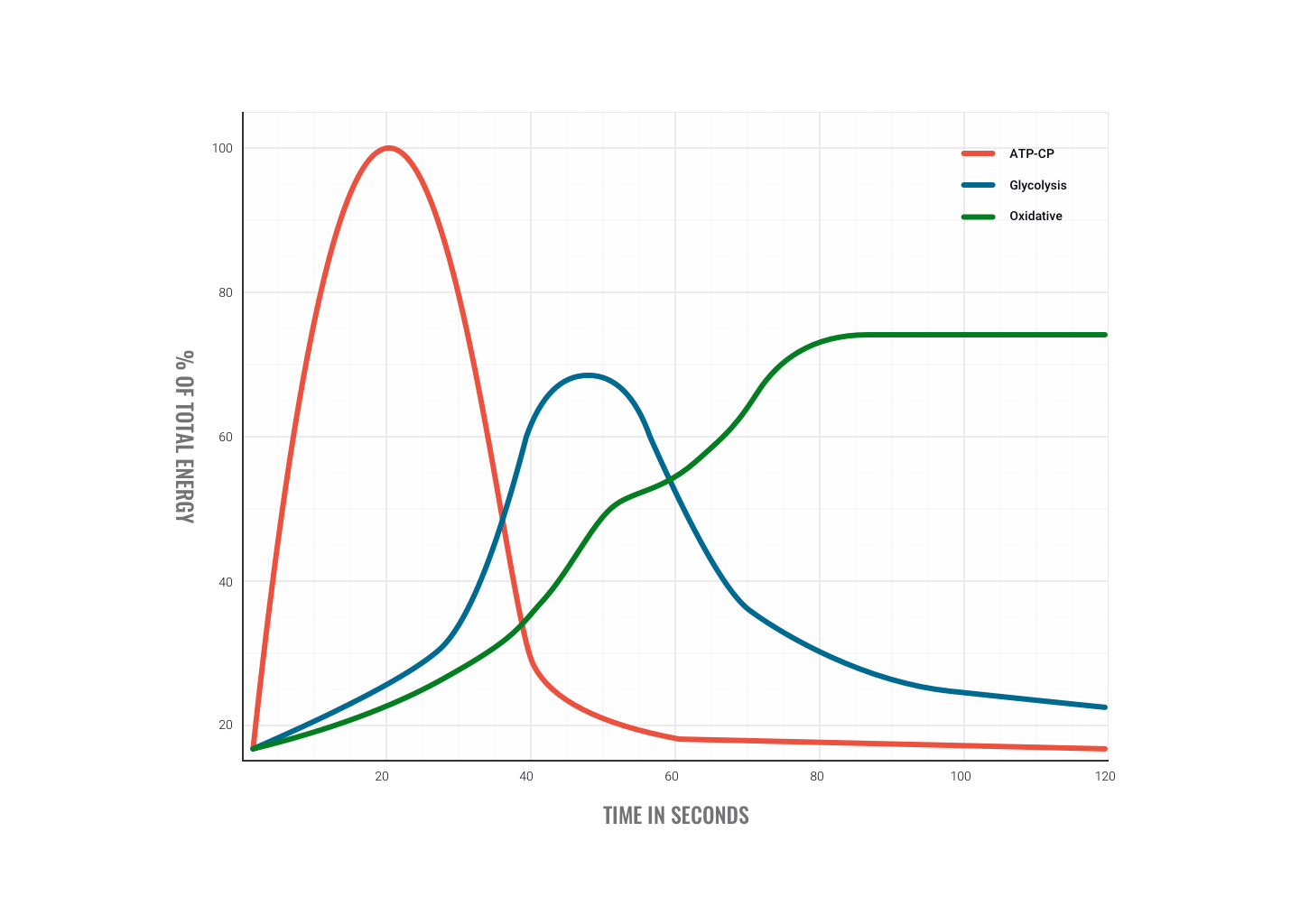
Watch
The following video discusses energy systems in more detail from the perspective of a fitness trainer.
Why do you need to know energy systems?
The main reason it is essential for you to have a working knowledge of energy systems is to ensure your programmes are set up to provide correct intensities, durations, rest periods, and training types specific to the sport or activity you are training. Your client's capacity to train depends on their ability to supply their muscles with enough ATP. Improving these systems is very specific to the training you do.
Adenosine triphosphate (ATP)
ATP is the body's energy currency. It comprises an adenosine molecule and three phosphate groups. The bonds holding the phosphates together (represented in the following illustration in red) are very high in energy.
When these bonds are split by an enzyme, a large amount of energy is released which can be harnessed for processes like muscle contraction. When the bond is broken, ATP becomes ADP (adenosine diphosphate).
You only have about 3 seconds worth of ATP stored in the body.
Exercise intensity and duration
Each system provides ATP at different levels of exercise intensity and duration. The systems are ordered from the highest intensity (ATP-PC) to the lowest intensity (Oxidative).
There are 2 anaerobic systems and 1 aerobic energy system. So, what do anaerobic and aerobic mean?
- Anaerobic means oxygen (supplied by our cardiovascular system) is not required for this system to function at full capacity. Anaerobic systems are relied on in the first seconds of intense exercise where there is insufficient oxygen.
- Aerobic means 'with oxygen' and refers to using oxygen in the muscle's energy-generating process. This generally means exercise is of lower intensity and has the capacity to supply large amounts of ATP relatively slowly.

The ATP-PC system is high power and short duration. It is the simplest and quickest system for producing energy for exercise. It is also the fastest at converting spent ADP back into usable ATP again. It provides energy for up to 5 to 12 seconds of maximal intensity physical activity.
It is used for activities such as jumping, short sprints, power lifting, and other maximal activities. However, the system is active at the beginning of all exercises, regardless of their intensity. The system relies upon the breakdown (hydrolysis) of ATP via an enzyme or creatine phosphate (CP) as shown in the following equation.
Equation
ADP + CP ← enzyme activity → ATP + Creatine
What is creatine phosphate (CP)?
During intense exercise, ATP is used up in seconds and needs to be replenished using CP so that exercise can continue for up to 12 seconds. Creatine phosphate is a common supplement for those looking to increase speed, power or strength.
If you want to read more about creatine supplements in sports, expand the accordion.
The body is either in an energy release phase (i.e. during exercise or sport) or an energy regeneration phase (i.e. during recovery from exercise).
- Energy release: ATP ←→ ADP + P + Energy
- Energy regeneration: ADP + CP → ←→ ATP + C
The process is illustrated in the following diagram.

- Find the ATP molecule (blue) on the diagram; this is our starting point. This represents the small amount of ATP stored in the muscles ready to go instantaneously.
- Follow the cycle to the next station and you will see a Phosphate (P) split off from the ATP releasing energy for muscle contraction leaving us with ADP (two P with one split off).
- Next, you will see the ADP meet up with Creatine Phosphate (CP), the CP donates its P to the ADP and we are now back to where we started with a regenerated ATP molecule ready to make the muscle fibre contract again.
Time to fatigue
The US National Library of Medicine (2017) defines muscle fatigue in humans as 'exercise-induced decrease in the ability to produce force'. Take a look at the graph and then read the explanation that follows.
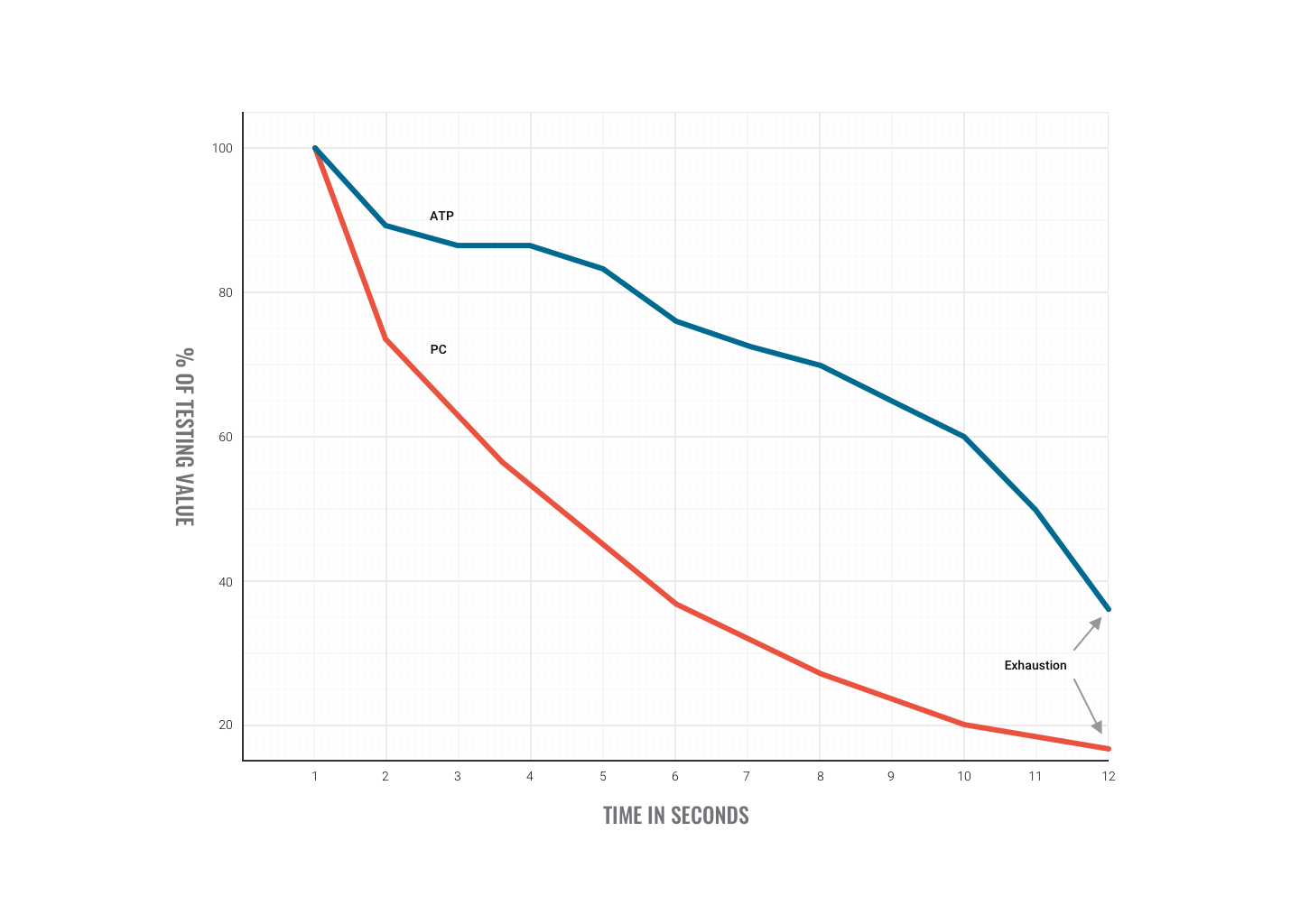
During the first few seconds of intense muscular activity (sprinting), ATP is maintained relatively constant, but PC declines as it is used to replenish ATP. The main limitation of very intense exercise duration is PC depletion. At exhaustion, both ATP and PC levels are low.
Your ATP and PC stores can sustain the muscle’s energy needs for 5-12 seconds in an all-out sprint. Beyond this point, ATP-PC contribution decreases, and the muscles rely more on other systems of ATP formation, i.e., the glycolytic and oxidative energy systems.
A one-off maximal contraction like a shot put toss, competition weightlifting lift, or a single vertical jump does not require using the ATP-PC system. There is stored ATP in the muscle which can provide for these instantaneous explosive movements. The ATP-PC system must be activated once the stored ATP has been depleted after 2 to 3 seconds.
The Wattbike test
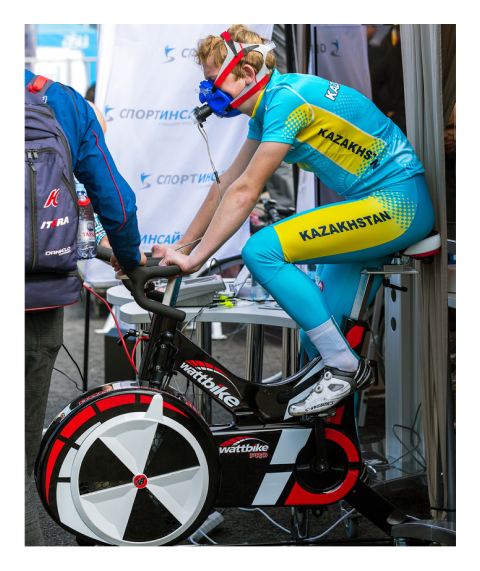
The Wattbike was developed by British cycling as a specialised ergometer for elite cyclists. It was designed to mimic real cycling and is equipped with a wide range of tests and training programmes well suited for anyone looking to improve their conditioning in a low-impact manner. Due to their programmability and functionality, they are almost universally used in elite sports and other training facilities.
The Wattbike has a six-second sprint test that measures the power of your ATP-PC system. It requires you to pedal as fast as you can for six seconds and measures the power you can produce over this timeframe. The example here shows the subject could average 1850 watts and 200 rpm over six seconds. This is an Olympic sprint cyclist level! Test results may look like the following.
| Power Peak Test 6 seconds | Results |
|---|---|
| Power Peak | 1850 watts |
| Cadence Peak | 200 rpm |
A cadence peak in cycling, or pedal speed, is measured in pedal stroke revolutions per minute (RPM). For example, a cadence of 50 RPM means that one pedal makes a complete revolution 50 times in one minute.
A practical example of ATP-PC system training
Imagine you have prescribed some maximal strength training for a client wishing to improve her strength. You have prescribed 5 sets of 4 reps of some compound exercises with 90 seconds rest between sets.

This would be a good session for maximal strength and ATP-PC system development except the rest periods are too short. The 4th heavy rep will completely deplete your client's phosphocreatine fuel. It will now require approximately three minutes of rest to replenish the PC stores fully.
If the client started the second set after 90 seconds of rest, she would start with the PC stores only about 70% replenished which could result in running out of PC at rep 3. As soon as the PC stores run low the body will need to switch to the next available energy system, the glycolytic. However, this system is not as powerful as the ATP-PC so the client would need to lower intensity, stop early, or lower weight. Over a few weeks, this would result in greatly diminished strength training adaptation.

The glycolysis system equates to moderate power and moderate duration. Glycolysis refers to the splitting of glucose. This process involves the anaerobic breakdown of glucose to produce ATP and provides energy for up to 2 minutes. Examples of exercises include team sports like rugby, soccer, and netball, HIIT (high intensity interval training), hypertrophy training, and 800m running. The primary fuels for glycolysis are blood glucose and muscle glycogen.
Muscle glycogen is a stored form of glucose located in the muscle and liver. If you are not immediately active after a meal most of the glucose from carbohydrate (CHO) breakdown will be stored for future exercise. When you exercise next, this glycogen will break down into glucose and enter glycolysis.
Glycolysis is more complex than the ATP-PC system and involves twelve reactions which ultimately produce pyruvic acid.
- Anaerobic glycolysis is used during high-intensity activity (predominantly between 15-60 seconds) where glucose is broken down to pyruvic acid which then converts to lactic acid.
- Aerobic glycolysis is used during low-intensity activities (greater than 60 seconds). Due to the lower intensity, pyruvic acid has time to be transported into the aerobic system where it is fully processed.
To read about the chemistry happening during glycolysis, expand the accordion.
For every glucose used, 2 ATPs are formed from glycolysis. Look at the following diagram and then read the explanation.
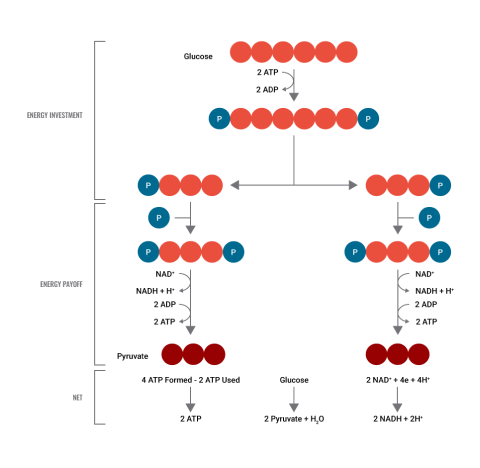
- The fuel for glycolysis is glucose which you can see at the top of the diagram. Glucose has 6 carbon atoms represented by the orange circles.
- The addition of 2 phosphate molecules arises from the breakdown of 2 ATP molecules.
- This 6 carbon, 2 phosphate compound, is split into 2 parts, each with 3 carbons and 1 phosphate molecule.
- After several complex chemical reactions, the net products are pyruvic acid (or pyruvate) and ATP.
You will note on this diagram NAD → NADH +H being produced. This NADH will be transported to the aerobic system where it will produce large amounts of ATP when oxygen is present.
Pyruvate, the end product of glycolysis, is either utilised as an energy source by its conversion into lactate or is taken up by the mitochondria of the cells.
A practical example of the glycolytic system training
Imagine you have a fit, athletic client who has just started doing some hard glycolytic training to prepare for an upcoming sports season. The client lets you know that he has tried doing a series of maximal 30-second efforts with a full 4 minutes recovery between reps. He explains that after the first rep, he cannot recover, and he gets slower and slower with each rep. He is worried that he is not fit enough to finish the workouts.

This is a common issue with glycolytic training. The client is correct in choosing 30-second efforts to maximally test this system. However, what you will find is the glycolytic system is a ‘one-hit-wonder’; it is good for maintaining one maximal prolonged effort but is not able to recover well for additional reps.
The following graphs demonstrate what has occurred. In this example, the client did 2 maximal sprints of 30 seconds with 4 minutes of recovery between; and you can see the ATP contribution each system is making to these efforts. As you would expect, the first rep is predominately supported by the glycolytic system. However, in the second rep, the glycolytic system is still fatigued and has not recovered, therefore the aerobic system steps in to take the load.
The aerobic system is not as powerful as the glycolytic system, so the client's speed drops considerably. The aerobic contribution increases and power drops with each successive rep. This is a natural response to this training style, so you could let the client know it may not be low fitness levels causing this.


Without the oxidative system, exercise might be limited to only a few minutes. This system is the long-term provider of ATP. The oxidative system is aerobic and involves the breakdown of glucose, fat, and protein in the presence of oxygen. It is the only system that uses oxygen to help with energy production. It utilises the breakdown of other macronutrients (fat and protein) using oxygen to produce energy. This system is best suited for exercise lasting longer than 3 mins in duration.
Exercise types include long-distance or high-volume exercises such as lap swimming, cycling, and jogging.
Where does the oxidative system occur in the muscle?
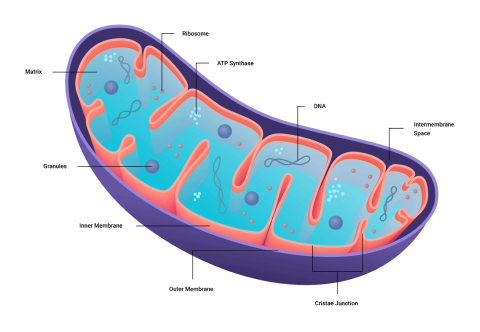
All oxidative metabolism occurs in the part of the cell called the mitochondria. In the following image of the muscle fibres, you will see that the mitochondria (where all the aerobic processes occur), and the supply of fuel in glycogen and fat are very close. ATP will leave the mitochondria and go straight to the muscle next door. One of the aerobic training adaptations is an increased number and size of mitochondria.
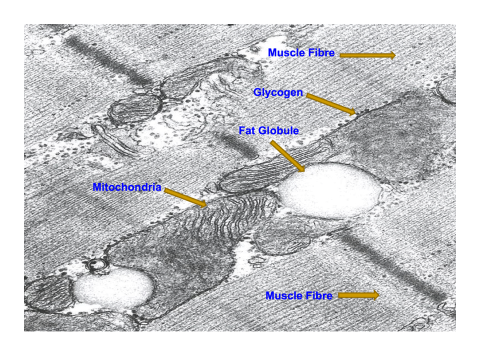
The burning or metabolism of carbohydrates to produce ATP involves 2 processes which both take place in the mitochondria:
- Krebs cycle
- Electron transport chain
To read more about the 2 processes, expand the accordions.
The Krebs Cycle (also known as the citric acid cycle) accepts the pyruvic acid generated previously in glycolysis and processes it further in the presence of oxygen. Pyruvic acid is converted to acetyl CoA which is a universal entry point into the oxidative system.
Acetyl CoA enters the Krebs cycle, which is a complex series of chemical reactions that spin like a wheel producing ATP and C02. NADH is a high-energy compound that will be transported to the electron transport chain (ETC) later to produce ATP. Acetyl CoA can be considered the universal entry point of all macronutrients into the aerobic (oxidative) system.
Remember, pyruvic acid is simply the glucose we started glycolysis with, that split in two halves. Universal simply means that the oxidative/aerobic system can only use one fuel type, much like your car (diesel in a petrol car won't work). Your oxidative system can only use Acetyl CoA as fuel.
Look at the diagram of the Krebs cycle and read the accompanying explanation.

- Pyruvate (or pyruvic acid) is at the top of the diagram. It simply follows on from glycolysis. Pyruvic acid is made of 3 carbons, it loses one carbon (C) to CO2 and turns into Acetyl CoA which is made of the remaining 2 carbons.
- The Acetyl CoA then enters the Krebs cycle where it spins around and gets further metabolised, producing more CO2, ATP, NADH/FADH. The CO2 is breathed out, the ATP is used to do work, and the NADH/FADH2 is transported to the ETC (electron transport chain) where it makes more ATP later.
- The harder you exercise, the faster this cycle spins and the more pyruvic acid you need from glycolysis.
The ETC is a complex series of reactions that take place in the mitochondria. This third stage is responsible for most of the ATP production during exercise. It takes the FADH2 and NADH formed during the Krebs cycle and glycolysis and uses them to produce more ATPs. Exercise, as well as good nutrition, allows your ETC to work more effectively providing more energy (ATP) during exercise.
A practical example of the oxidative system training
Imagine you have prescribed some aerobic exercise to a client wanting to lose weight. You give the client 30 minutes of cardiovascular exercise. Unfortunately, you miscalculate their current fitness level and start the client off at a treadmill speed of 10 kph (6 mins/km). However, their aerobic threshold is 8 kph. This means their aerobic system can provide enough ATP up to 8 kph after which the glycolytic system will need to ‘top-up’ any deficit or shortfall in ATP production.

As soon as you need to top-up the shortfall with the glycolytic system you will produce lactic acid which causes rapid fatigue as well as physical discomfort. This will diminish the quality and enjoyment of this aerobic exercise session by the client and potentially hinder their progression.
Fitness testing will help you find appropriate training intensities for your clients.

Fat is an almost limitless source of energy, whereas carbohydrates are a very limited source of energy to fuel ATP production. Someone who can supply the O2 (strong heart and lungs) required to burn fat will generally have better endurance due to the sparing of valuable carbohydrate supplies.
Fats are made up of free fatty acids (FFA) that can produce ATP in a process called beta-oxidation. Beta oxidation occurs within the mitochondria and involves converting FFA to acetyl CoA. Acetyl CoA enters the Krebs cycle just as it does with glucose metabolism, but more acetyl CoA is produced from fat than carbohydrate, so the energy yield is far greater.
| Process | ATP produced |
|---|---|
| ATP-PCr | 1 |
| Anaerobic glycolysis | 2 |
| Oxidation of carbohydrates (CHO) | 39* |
| Oxidation of free fatty acids (FFA) | 129** |
* This is how much ATP is produced if glucose is used as a fuel in the oxidative system. The body prefers to use glucose as a fuel because it requires less oxygen to burn.
** This is how much ATP is produced if fat is used as fuel in the oxidative system. You can see that fat is an excellent source of stored fuel compared to CHO. However, large amounts of oxygen are required to burn fat.
The chemistry behind burning fat as a fuel
The body prefers to use glucose as fuel compared to fat. Why is this? Take a closer look at the chemical equations that represent the burning of glucose and fat.
Glucose: C6H12O6 + 6O2 → 6CO2 + 6H2O + Energy
Fat: C55H104O6 + 78O2 → 55CO2 + 52H2O + Energy
This might all look quite complicated but really, it's quite simple! You can see both fat and glucose are made of the same things: carbon, hydrogen, and oxygen, but in different quantities. The key difference for our focus here is the amount of oxygen needed to burn fat compared to glucose; 78 for fat compared to just 6 for glucose.
Where does this oxygen come from? It has to be supplied by your cardio-respiratory system (your heart, lungs, blood, and blood vessels). As so much oxygen is hard to supply, the body likes the ‘easy option’ of just having to supply six O2s.
Not only does your cardio-respiratory system have to transport the 78 O2 to the muscle, but it also needs to transport the 55 CO2 back to the lungs to be exhaled. This is why unfit people fatigue quickly. They cannot burn fat effectively because they cannot transport enough oxygen and tap into glucose which runs out fast and produces lactic acid.
If you have a powerful aerobic system you will be very well placed to supply this oxygen during times of need, like hard exercise!
Aerobic power (V02max)
Aerobic power describes how effective your oxidative energy system is at producing ATP during exercise.
One of the leading predictors of good health is your aerobic power or VO2max. This is the ability of your muscles to use oxygen it receives from the heart and lungs to produce energy (ATP). For this reason, the largest VO2max is typically seen in endurance sports athletes.
VO2max is typically measured in millilitres per kg of body weight per min (ml/kg/min) at maximal exercise. The higher this number the more aerobically fit you are. It is a good fitness test for clients as it is an accurate predictor of aerobic fitness. The VO2max test typically involves laboratory equipment and is performed with qualified professionals.
Did you know? The highest VO2max recorded in a human was 96 ml/kg/min for a cross-country skier? VO2max has been calculated for other animals. E.g.:
- a thoroughbred racehorse has a VO2max around 190 ml/kg/min at 515 kg
- a husky dog around 230 ml/kg/min
- the highest VO2max in a mammal is the pronghorn antelope with an estimated 300 ml/kg/min allowing it to run 10 kilometres in about 10 minutes!
The following table compares female and male values in millimetres (ml), kilograms (kg), and minutes (min).
Female (value in ml/kg/min)
| Age | Very Poor | Poor | Fair | Good | Excellent | Superior |
|---|---|---|---|---|---|---|
| 13-19 | <25.0 | 25.0-30.9 | 31.0-34.9 | 35.0-38.9 | 39.0-41.9 | >41.9 |
| 20-29 | <23.6 | 23.6-28.9 | 29.0-32.9 | 33.0-36.9 | 37.0-41.0 | >41.0 |
| 30-39 | <22.8 | 22.8-26.9 | 27.0-31.4 | 31.5-35.6 | 35.7-40.0 | >40.0 |
| 40-49 | <21.0 | 21.0-24.4 | 24.5-28.9 | 29.0-32.8 | 32.9-36.9 | >36.9 |
| 50-59 | <20.2 | 20.2-22.7 | 22.8-26.9 | 27.0-31.4 | 31.5-35.7 | >35.7 |
| 60+ | <17.5 | 17.5-20.1 | 20.2-24.4 | 24.5-30.2 | 30.3-31.4 | >31.4 |
Male (value in ml/kg/min)
| Age | Very Poor | Poor | Fair | Good | Excellent | Superior |
|---|---|---|---|---|---|---|
| 13-19 | <35.0 | 35.0-38.3 | 38.4-45.1 | 45.2-50.9 | 51.0-55.9 | >41.9 |
| 20-29 | <33.0 | 33.0-36.4 | 36.5-42.4 | 42.5-46.4 | 46.5-52.4 | >41.0 |
| 30-39 | <22.8 | 31.5-35.4 | 35.5-40.9 | 41.0-44.9 | 45.0-49.4 | >40.0 |
| 40-49 | <21.0 | 30.2-33.5 | 33.6-38.9 | 39.0-43.7 | 43.8-48.0 | >36.9 |
| 50-59 | <20.2 | 26.1-30.9 | 31.0-35.7 | 35.8-40.9 | 41.0-45.3 | >35.7 |
| 60+ | <17.5 | 20.5-26.0 | 26.1-32.2 | 32.3-36.4 | 36.5-44.2 | >31.4 |
Energy systems can be daunting, particularly if you aren't fond of chemistry. The following tables summarise the 3 energy systems.
Table 1: Energy systems, activity, and ATP produced
| Energy system | Activity | ATP produced |
|---|---|---|
| ATP-PCr | Very high intensity, short duration (6-10 seconds) without the use of oxygen (i.e. anaerobic); active at the onset of all activity | 1 |
| Anaerobic glycolysis | High intensity, short-to-moderate duration (10-90 seconds) without the use of oxygen | 2 |
| Oxidative phosphorylation (aerobic) | Low-to-moderate intensity, long duration (>90 seconds) | Carbohydrates 36-39 |
Table 2: Speed of ATP produced by each system
| Fuel and system | Relative speed of ATP production |
|---|---|
| Phosphocreatine (ATP-PC) | 100 |
| Glucose (anaerobic glycolysis) | 55 |
| Glucose (aerobic glycolysis) | 23 |
| Fats | 10 |
Table 3: Intensity, duration, fuel, by-products, and recovery by energy system
| ATP-PC | Glycolysis | Oxidative | |
|---|---|---|---|
| Intensity | Very hard | Hard | Light to moderate |
| Duration | <10 seconds | Up to 90 seconds to 2 minutes | Up to several hours, as long as there is enough fuel |
| Fuel | PCr | Glucose | Glucose, fat, protein |
| By-products | None | Lactic acid | C02, H20, heat |
| Recovery | 3-5 minutes | As long as it takes to remove lactic acid |
Check that you have a good grasp of energy systems before attempting the muscular system and energy systems test.
